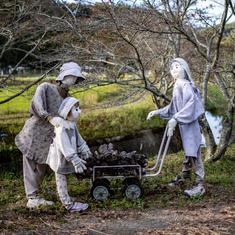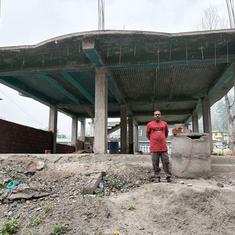Kalimpong mourned, in February, the passing of its celebrated citizen, Gyalo Thondup, elder brother of the Dalai Lama. Thondup, who had lived in this Himalayan town with his Chinese wife Diki Dolkar (Zhu Dan) since the 1940s, wrote a captivating book in 2015 titled The Noodle Maker of Kalimpong.
Chronicled events here were impelled by the historic location of Kalimpong itself, a multi-ethnic mofussil town situated at the crossroads of both geography and history. It facilitated Dhondup’s intense involvement as the go-to intermediary for dealing with Beijing, Washington, Delhi, London and European capitals on the Tibet Question on behalf of the Dharamshala government-in-exile.
Around the edgy Tibetan Autonomous Region (TAR), the India-China enmeshment is marked by what all states suffer: anxiety by definition. A post-colonial India (after 1947) and a post-revolution China (after 1949) remain nervous nations hovering over their anxious states.
Haunting these narratives into the larger body politic of the two nations and Tibet stands Kalimpong as a junction. It cannot thus be easily written off as peripheral or even just a shadow place.
As the civil war raged on in China (fought intermittently between 1927 until Communist victory in 1949), Thondup – who was still living in Tibet – had the ambivalent blessings of the Guomindang leader Chiang Kai-Shek to position Tibet’s cause. When Mao Zedong’s revolutionaries took over mainland China in 1949, Chiang Kai-Shek would go on to found the island-nation of Taiwan.
Thondup visited Kalimpong before the Chinese takeover of Tibet in the 1950s. It had long functioned as a node for the Tibetan cause. The town sits 120 km from Jelep-La or “tranquil pass”, the favoured crossing point at 14,390 feet between Tibet and the eastern Himalayas where the great mule trains of the Tibetan clan Pangdatsang thundered their way to Lhasa.
Kalimpong was known as the Harbour of Tibet, serving as the southern terminus of a flourishing Indo-Tibetan trade with Tibet and China. Manufactured luxury goods (knocked down cars, Rolexes and Parker fountain pens) made their way up on mule trains that returned with yak wool and Chinese silver dollars.
Fortunes were in Kalimpong for the making, attracting merchants and adventurers from Rajasthan, northwestern India and Kathmandu. Traders settled in the town circuited back and forth from Lhasa and Kham (part “outer Tibet”) and the Chinese territories.
Jelep-La now stands forbidden for the curious. The other, more arduous mountain crossing of Nathu-La is a four-hour drive on jeeps from Sikkim’s capital of Gangtok through a highly militarised border redolent with the smell of diesel and jalebis.
A leading player in this exchange, between the 1930s up until the late 1950s, was Ma Zhucai. It was in the miscellany of the “Tibet-Yi ethnic corridor” (comprising of Tibetan, Hui, Han, Yi, Nakhi, Hani, Lisu, Lahu, Jinuo, Pumi, Jingpo et al) that Ma Zhucai grew up near Gyalthang, where ethnic groups mingled while travelling intensively and extensively. He worked for a caravan business trading into Southeast Asia and Kalimpong before he quickly rose to run an extremely fruitful firm he named Zhu Ji.
Competing with businesses operated by Reting, Pangdatsang and Sadutsang clans, Ma Zhucai’s was among the larger of the dozen or so caravan companies headquartered in Kalimpong, where he lived for 41 years. With the proceeds from his trade, he not only helped found the Kalimpong Chung Hwa Chinese School, procured rare manuscripts for a monastery in Tibet but also contributed generously towards buying fighter planes for China to battle the Japanese during World War II.
He was arrested in 1960 and charged with being the Chinese spy-chief after the murder of Lama Lobsang Doma in the haat bazaar of Kalimpong. It was to become an international cause célèbre, with the Chinese foreign ministry arranging to extract Ma via Rangoon. Thus, even before India’s 1962 war with China, the inhumane treatment of Chinese nationals and Indians of Chinese origin was on the map.
Ma’s grandson would go on to start the trade-centred Ancient Tea and Horse Road Museum in 2016 in his old hometown of Gyalthang, now rechristened as Shangri-La. Ma is celebrated in China as a hero, having traded in treacherous places between Kalimpong and Yunnan in south-western China.
This Kalimpong transnational tale subverts tidy nationalistic narratives and does not venerate close-fitting borders. Other minor characters – Chinese, Tibetan, Japanese, British spies, white and red Russians, amongst many others – sloshed around the town from the 1920s with traders, aristocrats, mystics, missionaries, travellers, reformers, and subalterns, all presences that provide texture and tone to the palimpsestic world of Kalimpong. The superdiversity of the town allowed it to become the node for innumerable exchanges.

No wonder, by the 1950s, Indian Prime Minister Jawaharlal Nehru and Chinese Premier Zhou Enlai traded words about Kalimpong being a command centre for people fomenting trouble and insurgency in Tibet and China. Nehru wondered, “Sometimes I begin to doubt whether the greater part of the population of Kalimpong does not consist of foreign spies.”
Beijing’s security orientation was to use teqing (special intelligence agents) not inside Tibet but in Kalimpong. One such agent who served as the headmaster of Chung Hwa Chinese School in Kalimpong between 1940 and 1956 while doubling as honorary liaison officer of the Mongolian and Tibetan Affairs Commission was Shen Fumin, who observed that he “could not support the British Imperialistic Policy regarding Tibet & China and in fact towards all Asiatic races”.
He was later to teach art at the local Swiss Jesuit school whose students remember him fondly as a truly masterful watercolourist and a stern draughtsman who, with a few deft strokes, could evoke a Chinese landscape.
That the cosmopolitan Thondup partook of the town’s superdiversity, ran a rather prosperous noodle factory and occupied himself in diplomatic (read as involvement in espionage) engagements for Tibet also gestures to the enigmatic and marvellously complex fabric of his adopted town, Kalimpong.
Prem Poddar is the author, with Lisa Lindkvist Zhang, of Through the India-China Border: Kalimpong in the Himalayas (Cambridge University Press, 2024).











